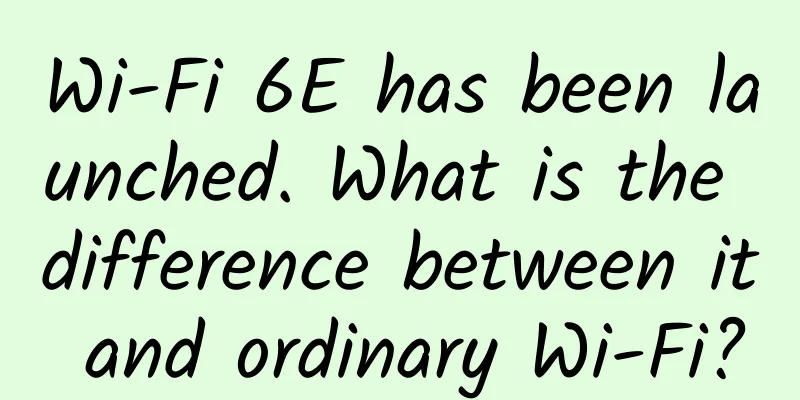Wi-Fi 6E has been launched. What is the difference between it and ordinary Wi-Fi?

|
On September 2 last year, ROG released a high-end gaming router equipped with a 2.5Gbps LAN port and a power amplifier, which enabled its tri-band concurrent rate to reach 11000Mbps. More importantly, this router is also the first router product in the industry to support the Wi-Fi 6E standard.
Many people wonder what Wi-Fi 6E is? How is it different from the Wi-Fi we usually use? Today, I will show you the latest Wi-Fi technology. What is Wi-Fi 6? Before introducing Wi-Fi 6E, we must first understand what Wi-Fi 6 is. The so-called Wi-Fi 6 refers to the sixth generation of wireless network technology. The routers in our homes now generally use Wi-Fi 4 and Wi-Fi 5 technologies. Many people will ask, they are both Wi-Fi, what is the difference? The first is the increase in speed. Every time the network technology is upgraded, the first thing that is improved is the transmission speed. So how much speed has Wi-Fi 6 increased? Let's compare it with the currently commonly used Wi-Fi 5. At present, the theoretical maximum transmission speed of Wi-Fi 5 is 6.9Gpbs, and the maximum single-flow speed is 867Mbit/s. Wi-Fi 6 increases the transmission speed to 9.6Gpbs, and the single-flow bandwidth reaches 1201Mbit/s . You may be a little confused by these data. I will convert them into MB/s, which is more familiar to you. After conversion, the maximum single-flow speed of Wi-Fi 5 is 6939MB/s, while that of Wi-Fi 6 reaches 8168MB/s. The network connection speed is increased by 1.4 times. However, what is important for Wi-Fi 6 is not the increase in speed, but the technological innovation. The use of OFDM orthogonal frequency division multiplexing technology and MU-MIMO technology allow Wi-Fi to provide devices with a stable network connection experience in scenarios where multiple devices are connected. In our lives today, more and more devices need to connect to the Internet. In addition to mobile phones, computers, TVs, game consoles, and even home appliances such as refrigerators and washing machines all need to connect to Wi-Fi. When many devices are connected to the same Wi-Fi network at the same time, the most intuitive experience is that the network speed feels slower. For example, if you are downloading a movie on your computer, there will be lags when playing a high-definition movie on a smart TV connected to the same Wi-Fi, and there will be delays when controlling a smart washing machine connected to the network with a mobile phone . This situation is like a road. If a large number of vehicles converge on one road, congestion will eventually occur. The same is true for the use of Wi-Fi networks. In order to allow Wi-Fi to connect to more devices, it is necessary to keep the network bandwidth running smoothly. Therefore, MU-MIMO technology is added to Wi-Fi 6 to improve the efficiency of Wi-Fi network and keep the transmission speed smooth and stable in an environment with multiple devices connected. MU-MIMO is one of the most important features of Wi-Fi 6. It improves network throughput and total capacity, expands data transmission channels, and improves network resource utilization and performance. If there are too many connected devices, the network speed will slow down. The main reason is that the previous network protocol can only establish communication with devices one by one. Once too many devices are involved, devices that are not connected to the network will queue up and wait for access. Although they are not connected to the network, they will also occupy a communication channel, causing the network bandwidth to become narrower and the network will naturally become congested. In addition, the communication devices are allocated based on the average value of the total bandwidth of the router. According to the principle of communicating one device at a time, if a device with a 100MHz bandwidth is connected to 3 devices at the same time, each device will only have 33.3MHz of bandwidth. Therefore, in the same Wi-Fi network, the more devices are connected, the fewer network resources are allocated to the devices, and the slower the network speed will be. Under MU-MIMO technology, the router can establish communications with multiple terminals at the same time and work together. The signals of the devices will not interfere with each other, and the frequency resources allocated to each device will not be discounted. They can all obtain complete data traffic, making the most of network resources. In this way, when we use multiple devices to access the Internet, the Internet speed will naturally be very smooth without any lag. Another important technology in Wi-Fi 6 is OFDMA orthogonal frequency division multiplexing technology, which enables multiple devices to transmit simultaneously without the need for devices to wait or compete for signals, improving network efficiency and reducing device connection delays. To put it simply, in previous Wi-Fi, the three terminals were likened to three people. Although they had different destinations, they were all on the same route. However, they did not know each other and could only call a taxi to go to their destination. In this case, the router that allocates "vehicles" needs to allocate three "vehicles" to pick up and drop off three passengers. Although the communication distance and time of some devices are very small, they always occupy a lane on the road. When there are too many devices, the road becomes crowded. In Wi-Fi, OFDMA technology allows three terminals to "carpool", allowing them to ride in the same "car" and then get off at their destination. This form reduces the crowding of signal channels, and the network is naturally smoother. Having said all that, what is the difference between Wi-Fi 6 E and Wi-Fi 6? The extra E in Wi-Fi 6E stands for "Extended". In addition to the original 2.4Ghz and 5Ghz frequency bands, a new 6GHz frequency band has been added. What are the advantages of a new frequency band? In modern households, there are often multiple devices occupying broadband resources, and each device has different requirements for broadband. If 2.4Ghz and 5Ghz frequencies are mixed together, low-demand devices such as smart sensors and smart terminals will scramble for bandwidth resources. This will affect the network connection experience for devices with higher bandwidth requirements such as mobile phones, computers, and smart TVs. The new 6Ghz frequency is relatively idle and can provide 7 consecutive 160MHz bands, which has very high performance. And it will not interfere with the 2.4Ghz and 5Ghz frequency bands. In the scenario of multiple devices being connected, the connection frequency bands can be allocated more reasonably. Devices like smart home devices that do not need to occupy bandwidth can be allocated to the 2.4Ghz or 5Ghz frequency bands. Mobile phones, game consoles and other devices with high performance requirements are allocated to the 6Ghz frequency band. Different devices can use what they need, which does not waste network resources and meets the needs of connecting to the network. Wi-Fi 6E is so excellent, so will there be suitable application scenarios in the future? The answer is of course yes. First of all, in our homes, more and more devices need to be connected to the Internet. Wi-Fi 6E multi-band can reasonably allocate network resources, so that each device can obtain reasonable network resources, avoiding competition between devices for network bandwidth resources, resulting in freezes and high delays in the home network. In addition to the home field, Wi-Fi 6E plays a greater role in the commercial field. For example, in public places such as airports, experience centers, and restaurants, there will be a large number of device connections required. The number of device connections carried by the original Wi-Fi protocol is limited and cannot meet the public's usage needs. Under Wi-Fi 6E, not only the bandwidth capacity is improved. MU-MIMO and OFDMA can cope with the connection of multiple devices, allowing the network to carry the connections of more devices at the same time and meet the connection needs of user devices in public places. In addition, low latency and high data throughput can also enhance the experience of next-generation multimedia applications. For example, Stadia, a cloud gaming platform released by Google, mainly runs games on the cloud and then transmits the images to the player's screen, so that players can enjoy high-quality games without a high-configuration computer. Although the ideal is beautiful, cloud gaming has very high requirements for network data throughput. In addition, in order to ensure smooth operation of players, low-latency network access is also required. If these requirements cannot be met, the final gaming experience will be damaged. The high data volume and low latency of Wi-Fi 6E can solve the above two pain points and accelerate the implementation of various high-demand network applications. Of course, Wi-Fi 6E is not perfect. Higher signal frequencies will further weaken signal penetration, which is determined by physical properties. In addition, the newly added 6Ghz frequency band also increases the power of the router, making Wi-Fi 6E routers more power-consuming than Wi-Fi 6 routers. Currently, the Wi-Fi 6E band has certain advantages in speed and anti-interference due to the small number of devices installed. However, as the technology and supporting devices become more popular, signal diffraction interference will still occur in the 6Ghz band in the future, thus affecting the transmission speed of the wireless network. As a new generation of network technology, Wi-Fi 6 E will continue to improve our wireless network access experience, especially for multi-terminal device connections, which is more in line with our actual needs than increasing speed. Starting this year, Wi-Fi 6 and Wi-Fi 6E related products will be available on the market in large quantities. When purchasing equipment, you can make your judgment based on actual usage and the number of connected terminals in your home. |
<<: Finally someone has explained 5G+AI clearly
>>: In the post-epidemic era, what is the effect of 5G infrastructure investment?
Recommend
Software: Share 9 practical computer software, worth a look
Today I will share with you 9 practical computer ...
Summary information: Casbay/98 Cloud/Asia Cloud/Journey Cloud/PUAEX
I will continue to share some of the merchant sub...
"Rehabilitate" the Ethernet all-optical network! China Construction Association publishes the first standardization document for smart park construction
"Smart Park" is not a new concept. In t...
CYUN: 20% off on all VPS, 50% off for old users, Hong Kong VPS monthly payment starts from 14.5 yuan
CYUN is a cloud computing service brand under Hon...
Huawei's Hu Houkun: To promote the new development of 5G, the industry should prepare for the metaverse, 5GtoB and low-carbon development
On October 13, the 2021 Global Mobile Broadband F...
Smart homes need smarter Wi-Fi
Today's homes feature an increasing number of...
Jingwen Internet: Japan VPS free upgrade package, Japan server free upgrade 100M bandwidth, recharge 1000 and get 300 yuan
The last time I shared information about JWDNS wa...
"All-optical wireless starry sky" illuminates the road of intelligent manufacturing of Jinya Electronics
With the advent of the fourth industrial revoluti...
An article to show you how to use Nginx as a proxy for WebSocket
Hello everyone, I am Xiao Jiang. The previous art...
What are the 5G scenarios in digital transformation?
It is predicted that by 2025, there will be 1.2 b...
RackNerd: $11.88/year KVM-1.2GB/25GB/2.5TB/Los Angeles data center
RackNerd announced the hard disk upgrade of DC02 ...
What is structured cabling in a network system?
Structured cabling plays a vital role in network ...
A brief analysis of the technical difficulty of "number portability"
According to the Ministry of Industry and Informa...
Prospects and challenges of 5G messaging development
With the rapid development and popularization of ...
Huawei Network Energy "Innovation" on the Road
[51CTO.com original article] Introduction: "...





![[Important] IDC and Deepin Technology jointly released the technical white paper "Three Highs Application Delivery to Realize the All-Round Experience of Digital Natives"](/upload/images/67eb9cb13c0f1.webp)



